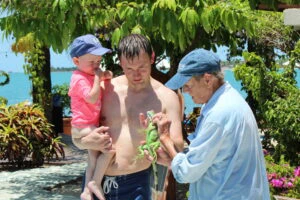While the Belize of today is known for its sumptuous jungles, complex networks of underground caves, and beautiful beaches, the region was incredibly arid 27,000 years in the past. The Last Glacial Maximum sealed much of the global moisture in glaciers and polar ice caps, and finding the next drink of water was as much a dire demand for creatures as hunting down the next meal.
That was especially true of the giant sloth. Towering at over four meters in height, the sloth required an understandably larger amount of hydration than some of its brethren. But it wasn’t dehydration that put the nail in the coffin of the sloth found in Belize. Divers discovered the tooth in what was just one of many underwater caverns, but at the time of its life, think sinkhole was likely a rare oasis in the sprawling desert of what would later become a tropical getaway.
While the tooth itself had begun the fossilization process, researchers were able to make investigate the tissue contained within for oxygen isotopes and stable carbon. It’s an advanced technique but one that allowed researchers a wealth of insight into the greater ecosystem that once defined the area. One of the big takeaways is that megafauna like the sloth weren’t done in by a single factor but instead by a whole convergence of environmental events. While the environmental scarcity of the time undoubtedly had an effect on their eventual extinction, the arrival of humans undoubtedly hastened their decline.
What’s especially exciting about this analysis is how it can be employed in the future. Bones that haven’t been fully fossilized yet can tell a lot about the diet of its owner, and that can spiral out to a greater understanding of the wider world surrounding them. Regardless, the Belize of today is very different from the Belize the sloth lived in.












